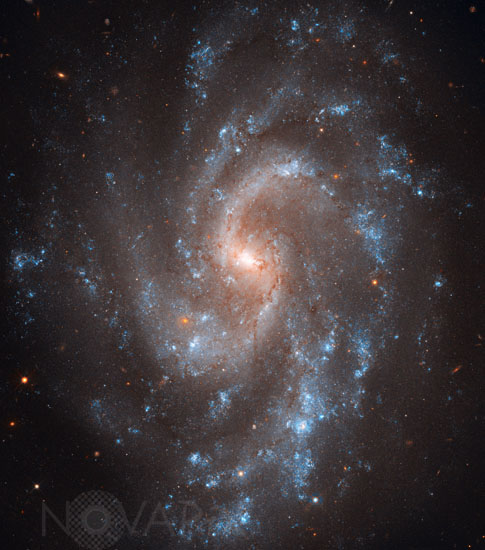Photo Agency - Astronomy - Space - Nature

Spiral galaxy NGC 5584
author: NASA/ESA/Hubble Heritage Team/Novapix
reference: a-gax55-84001
Image Size 300 DPI: 30 * 34 cm
The brilliant, blue glow of young stars traces the graceful spiral arms of galaxy NGC 5584 in this Hubble Space Telescope image. Thin, dark dust lanes appear to be flowing from the yellowish core, where older stars reside. The reddish dots sprinkled throughout the image are largely background galaxies.
Among the galaxy's myriad stars are pulsating stars called Cepheid variables and one recent Type Ia supernova, a special class of exploding stars. Astronomers use Cepheid variables and Type Ia supernovae as reliable distance markers to measure the universe's expansion rate. NGC 5584 was one of eight galaxies astronomers studied to measure the universe's expansion rate. In those galaxies, astronomers analyzed more than 600 Cepheid variables, including 250 in NGC 5584.
Cepheid variables pulsate at a rate matched closely by their intrinsic brightness, making them ideal for measuring distances to relatively nearby galaxies. Type Ia supernovae flare with the same brightness and are brilliant enough to be seen from relatively longer distances.
Astronomers search for Type Ia supernovae in nearby galaxies containing Cepheid variables so they can compare true brightness of both types of stars. They then use that information to calibrate the measurement of Type Ia supernovae in far-flung galaxies and calculate their distance from Earth. Once astronomers know accurate distances to galaxies near and far, they can determine the universe's expansion rate.
The image is a composite of several exposures taken in visible light between January and April 2010 with Hubble's Wide Field Camera 3.
NGC 5584 resides 72 million light-years away in the constellation Virgo.
Keywords for this photo:
2010 - ASTRONOMY - CEPHEID - GALAXY - HST - HUBBLE SPACE TELESCOPE - NGC 5584 - SPIRAL GALAXY - STAR - TYPE Ia - VARIABLE STAR - VIRGO -
Contact : Stéphane Aubin +33-(0)9-51-26-53-76
© Novapix - All rights reserved


